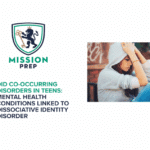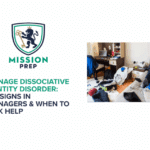Causes and Risk Factors of Dissociative Identity Disorder in Adolescents

If your teen acts out of character, forgets things they’ve said, or seems like they’re living in a dream world, you may be feeling frightened or overwhelmed. These issues may be making them seem like a different person from moment to moment, and you might be starting to suspect that something troubling is happening under the surface.
For some families, symptoms like these may indicate a frequently misunderstood mental health condition called “dissociative identity disorder” (DID). This condition often begins during childhood, which makes early awareness and intervention vital for receiving the correct treatment.
For parents, understanding what causes DID and the risk factors that make some teens more vulnerable can be the first step toward getting the professional support and help they need. Speaking to a mental health professional is often the first step in this process.
This article can also work as a useful guide for understanding the causes of dissociative identity disorder in teens, as it explores:
- What dissociative identity disorder in adolescents is
- The root causes of DID teens
- Key risk factors for DID
- Where to find professional support

What Is Dissociative Identity Disorder in Adolescents?
Dissociative identity disorder (DID) is a rare, yet serious mental health condition that is thought to affect up to two in every hundred people.1 In this disorder, someone experiences two or more completely separate personalities or identities, known as “alters”. These alters typically function entirely independently of each other, meaning they may have unique behaviors and memories.
Sometimes, people still refer to DID by its old terminology, “multiple personality disorder.” However, this term has not been used professionally since the 1990s, as it doesn’t accurately describe the condition. Dissociative identity disorder is more appropriate, as it recognizes that, rather than a person having many different personalities, there was once a single identity that is now fragmented. It also reflects the pivotal role that dissociation plays in this condition.
As DID can be a complex disorder to understand, some people find it helps to visualize it in ways such as the following:
Imagine that a person is like a house. The house has various rooms, each with distinct names, appearances, and functions. These individual rooms represent different alters in DID. You can visit each room, but you can never be in two rooms at the same time.
If you were to think about DID in this way, you can see how a person may have any number of differing identities inside them. However, they can only ever inhabit one of these identities at a time.
Recognizing DID in Teens
If you’re not overly familiar with DID, you may not know the signs or symptoms to look for. You can find a full description of DID symptoms in our guide, DID Signs in Teenagers, but for now, some examples of behavior you may notice in your teen include:
- Sudden changes in behavior or mood
- Seeming like a different person in terms of how they speak or what they enjoy doing
- Forgetting important information or appearing to have forgotten entire conversations
- Saying they feel disconnected from themselves, their surroundings, or reality
- Losing time in the sense that they can’t remember what they were doing, or how they got from one place to another
It’s good to remember that, although DID symptoms may appear confusing or frightening for your teen or yourself, DID usually develops as a response to very early childhood trauma. Therefore, it’s the mind’s attempt to protect itself from intensely distressing memories and requires empathetic and trauma-informed care.
The following sections focus on the main causes of DID in teens, so that you may better understand how and why it develops. Knowing the reasons behind the behavior can often mean that you can support your child and their condition with a more compassionate approach.
Core Causes of DID in Teens
As a parent, it can be heartbreaking to see your teen struggling with their mental health. Plus, if they’re showing signs of dissociation, you may be particularly concerned and want to better understand the root causes.
Typically, dissociative issues stem from the childhood trauma DID youth may have experienced, for example, abuse (physical, emotional, or sexual) or neglect. In fact, it’s estimated that 90% of people with DID have experienced early childhood trauma.2 Further, these traumatic experiences often occur over a prolonged period of time, causing ongoing and intense stress.3
For instance, DID can develop if the home the child lived in was frightening, such as in cases of disorganized attachment or living in areas of war.4,5 Additionally, studies suggest that more severe cases of DID are typically linked to very early abuse from a parent or main caregiver. 6
This information is not to cause upset or assign blame; it’s to raise awareness of the issues that can cause severe dissociation so that a teen can recover.
Next, we take a look at why the mind dissociates in response to trauma.
Why Does Dissociation Occur?
Dissociation is the mind’s way of protecting you from trauma – it’s a way of mentally distancing or detaching yourself from whatever is happening in the moment.
For very young children experiencing traumatic situations from which they are unable to remove themselves, dissociation can emerge as an effective coping strategy for their survival. Alternate identities may be created that can hold the traumatic memories, protecting the child from the emotional and psychological pain of trauma.
It’s important to note that dissociation isn’t a conscious choice for a child – it’s a triggered survival response, and they may have no control over it. For instance, childhood abuse and DID is linked because a child cannot consciously comprehend what has happened to them without experiencing extreme distress.
Yet, while dissociation may offer short-term benefits, it can have long-lasting effects on mental health. Specifically, if dissociation is a protective mechanism for someone experiencing early childhood trauma, without healing experiences, it may continue into adolescence and beyond, developing into dissociative identity disorder.
It’s helpful to note that dissociation can range in severity, from milder experiences such as daydreaming to the more severe end of DID – different identities. Therefore, it’s not uncommon for people to experience occasional episodes of dissociation. In fact, nearly a third of people say that they sometimes feel as though they are watching themselves in a movie.7 However, it is the severity and frequency of dissociative episodes, along with the presence of alters, that separate DID from occasional dissociation.
To many, DID may sound like an extreme form of PTSD. To help increase understanding, the following section looks at the similarities and differences between these conditions.
PTSD and DID in Teens
As DID is a protective mechanism triggered by trauma, it is often viewed as a severe form of childhood-onset post-traumatic stress disorder (PTSD).3 PTSD can develop after witnessing or experiencing something traumatic, and one of its symptoms includes dissociation. In fact, there is a specific dissociative subtype of PTSD that encompasses feelings such as the world or oneself not being “real.”8
While dissociation can be a primary component of PTSD, DID is a different condition from the PTSD dissociative subtype. Although both have their roots in trauma, PTSD can happen from trauma at any age, and often involves other symptoms, such as flashbacks, emotional numbness, or disconnection. In contrast, DID is specifically linked with early childhood trauma, resulting in the presence of distinct alters when the child’s identity fragments to cope.
Your teen may have had challenging experiences in their life that ultimately led to developing dissociative identity disorder, but remember that it is possible to recover from DID. With the right professional support and therapeutic approaches, healing is possible, and your teen can move forward to live a more fulfilling life.
Risk Factors That Contribute to Dissociative Identity Disorder in Adolescents
In addition to the causes of DID, certain factors may make an adolescent more vulnerable to the condition. Generally, when looking at risk factors dissociative identity disorder adolescents may possess, the following are examined:
- Genetics
- Changes due to adolescence
- Environmental factors
- Psychological triggers
Each of these potential risk factors shall be explored in turn below.
Genetic Factors DID Teens May Possess
There isn’t an abundance of research into connections between either genetics or family history in relation to developing DID. However, a few studies have been carried out, and data suggest there may be some genetic link to dissociative symptoms. This link involves genes related to serotonin and dopamine transmission, neural plasticity, and cortisol receptor sensitivity. However, it’s good to note that these findings are from small studies and show inconsistencies.9
Additionally, research involving medical imaging demonstrates that differences in brain activity regions have been detected between different alter identities. Furthermore, MRI studies show that the brain structure differs between patients with and without DID, specifically in the hippocampus and amygdala.6
Nonetheless, for any definitive conclusions to be drawn, more research is needed into this area.
Developmental Influences
Adolescence is a period when symptoms of mental illness often present themselves for the first time. So, while not a direct cause of DID, adolescence can be a time when symptoms begin to manifest due to the developmental changes and vulnerabilities that the teen years bring.
The adolescent brain goes through significant developmental changes, especially in areas related to emotion and cognitive control. These changes, together with other vulnerabilities and a history of childhood trauma, could influence a teen’s stress response and possible dissociation. 10,11
Furthermore, adolescence is a time when many teens begin to explore their personality and form their identity. Therefore, for a child with DID, becoming a teenager may make their distinct personalities, adolescent trauma, and dissociation more pronounced or difficult to hide from others.
Environmental Influences DID Adolescents Encounter
When taking into consideration factors for DID development, it is important to note the influence of the home and family relationships.
For example, if a child grows up in a home filled with chaos, abuse, neglect, or violence, their primary caregiver may not be able to consistently fulfil their needs. In the case of disorganized attachment, a child grows up with a primary caregiver who provides inconsistent, inadequate, or frightening care to them during the first few years of life. As a result, a child may develop different internal representations of themselves, such as different personalities or alters. By doing so, this enables them to continue a connection with the person they rely on for safety and comfort, but who also frightens them.6
Psychological Triggers DID Adolescents May Face
Many of the social stressors DID teens face daily could be potential psychological triggers for alters to rise to the surface.12 These stressors may provoke strong emotional reactions, such as feelings of rejection or abandonment, that may in turn trigger their coping mechanism: dissociation.
Some examples of psychological triggers could include:
- Bullying, including cyberbullying
- Academic pressure
- Conflicts with friends or family
- Criticism or accusations
- Interactions with authority figures
- Experiencing disrespect
- Having boundaries violated
- Feeling in danger
- Reminders of or associations with previous trauma
Although the above stressors may not be risk factors for developing DID, recognizing the events and situations that may trigger an alter change in your teen can be worthwhile. Similarly, finding ways to reduce unnecessary stress may have a positive impact on your teen and their overall mental well-being.

Mission Prep: Professional Support for Healing From Trauma
Dissociative identity disorder in adolescents can be a distressing and confusing condition to live with. However, understanding the causes beneath dissociation can be a powerful first step toward helping your teen heal. With the right support, recovery is entirely possible.
At Mission Prep, we help teens overcome their mental health challenges, including those living with DID. We understand how dissociation can feel overwhelming for teens, and our team of mental health experts offers personalized treatment, evidence-based therapies, and trauma-informed care to help them heal.
Our team also approaches the family as an integrated unit, recognizing the impact of trauma on all involved. For this reason, we encourage family involvement in treatment, supporting each member towards sustained stability and recovery. Contact us today to learn more about our trauma-informed treatment options.
References
- DID-Research. (n.d.). Prevalence. Retrieved September 11, 2025, from https://did-research.org/did/basics/prevalence
- Şar, V. (2014). The Many Faces of Dissociation: Opportunities for Innovative research in Psychiatry. Clinical Psychopharmacology and Neuroscience, 12(3), 171–179. https://doi.org/10.9758/cpn.2014.12.3.171
- Bistas, K., & Grewal, R. (2024). Unraveling the layers: Dissociative identity disorder as a response to trauma. Cureus. https://doi.org/10.7759/cureus.60676
- Mitra, P., & Jain, A. (2023, May 16). Dissociative Identity Disorder. StatPearls – NCBI Bookshelf. https://www.ncbi.nlm.nih.gov/books/NBK568768/
- Mayo Clinic. (n.d.). Dissociative disorders – Symptoms and causes. Retrieved September 16, 2025, from https://www.mayoclinic.org/diseases-conditions/dissociative-disorders/symptoms-causes/syc-20355215
- Sar, V., Dorahy, M., & Krüger, C. (2017). Revisiting the etiological aspects of dissociative identity disorder: a biopsychosocial perspective. Psychology Research and Behavior Management, Volume 10, 137–146. https://doi.org/10.2147/prbm.s113743
- Mental Health America. (2024, December 10). Dissociation and Dissociative Disorders. https://mhanational.org/conditions/dissociation-and-dissociative-disorders/
- Tull, M. (2023, February 1). Understanding PTSD and dissociation. Verywell Mind. https://www.verywellmind.com/how-trauma-can-lead-to-dissociative-disorders-2797534
- Rajkumar, R. P. (2022). The Molecular Genetics of Dissociative Symptomatology: A Transdiagnostic Literature Review. Genes, 13(5), 843. https://doi.org/10.3390/genes13050843
- Sturman, D. A., & Moghaddam, B. (2011). The neurobiology of adolescence: Changes in brain architecture, functional dynamics, and behavioral tendencies. Neuroscience & Biobehavioral Reviews, 35(8), 1704–1712. https://doi.org/10.1016/j.neubiorev.2011.04.003
- Holder, M. K., & Blaustein, J. D. (2013). Puberty and adolescence as a time of vulnerability to stressors that alter neurobehavioral processes. Frontiers in Neuroendocrinology, 35(1), 89–110. https://doi.org/10.1016/j.yfrne.2013.10.004
- Cleveland Clinic. (2025, September 17). Dissociative Identity Disorder (Multiple Personality Disorder). https://my.clevelandclinic.org/health/diseases/9792-dissociative-identity-disorder-multiple-personality-disorder



















